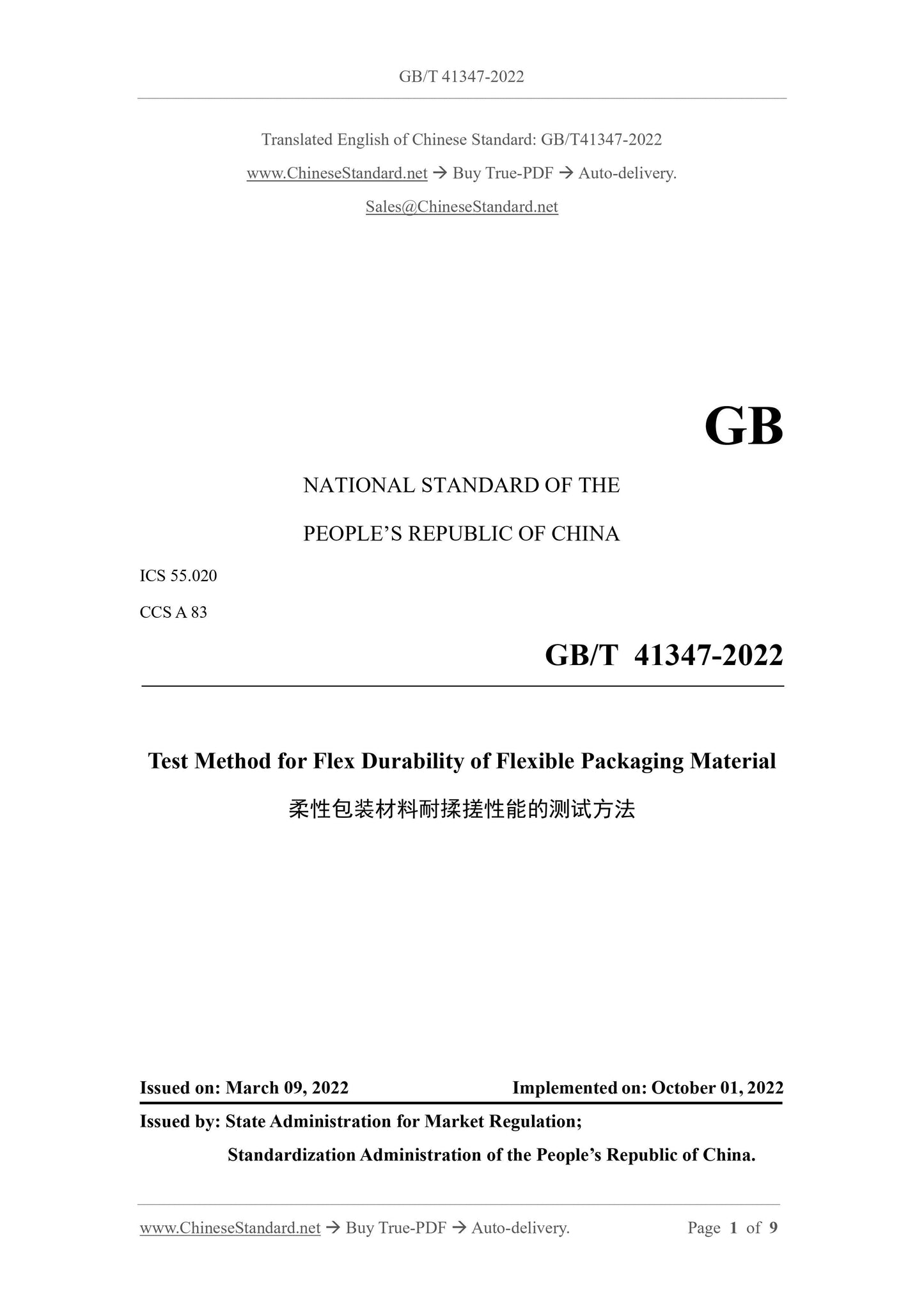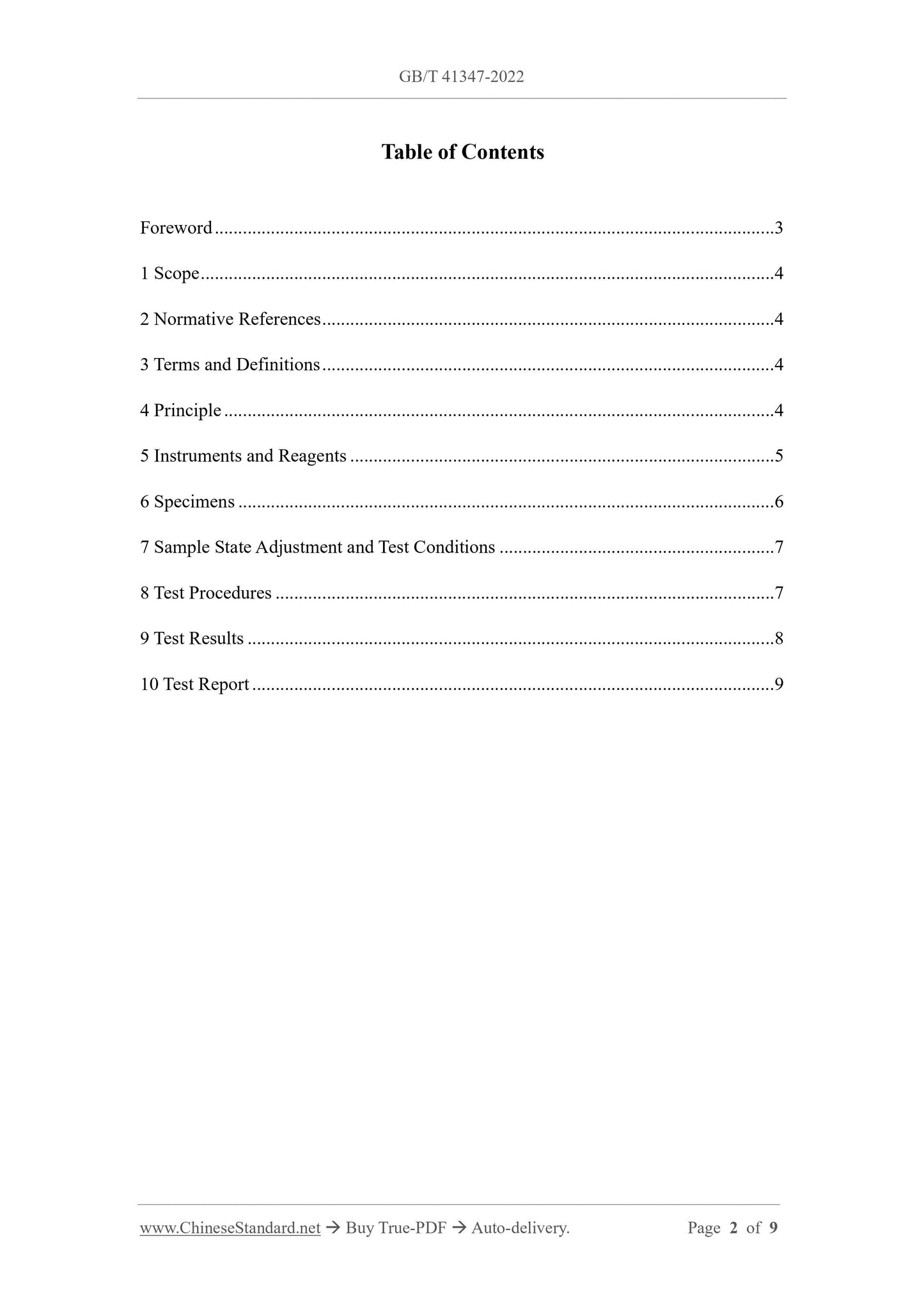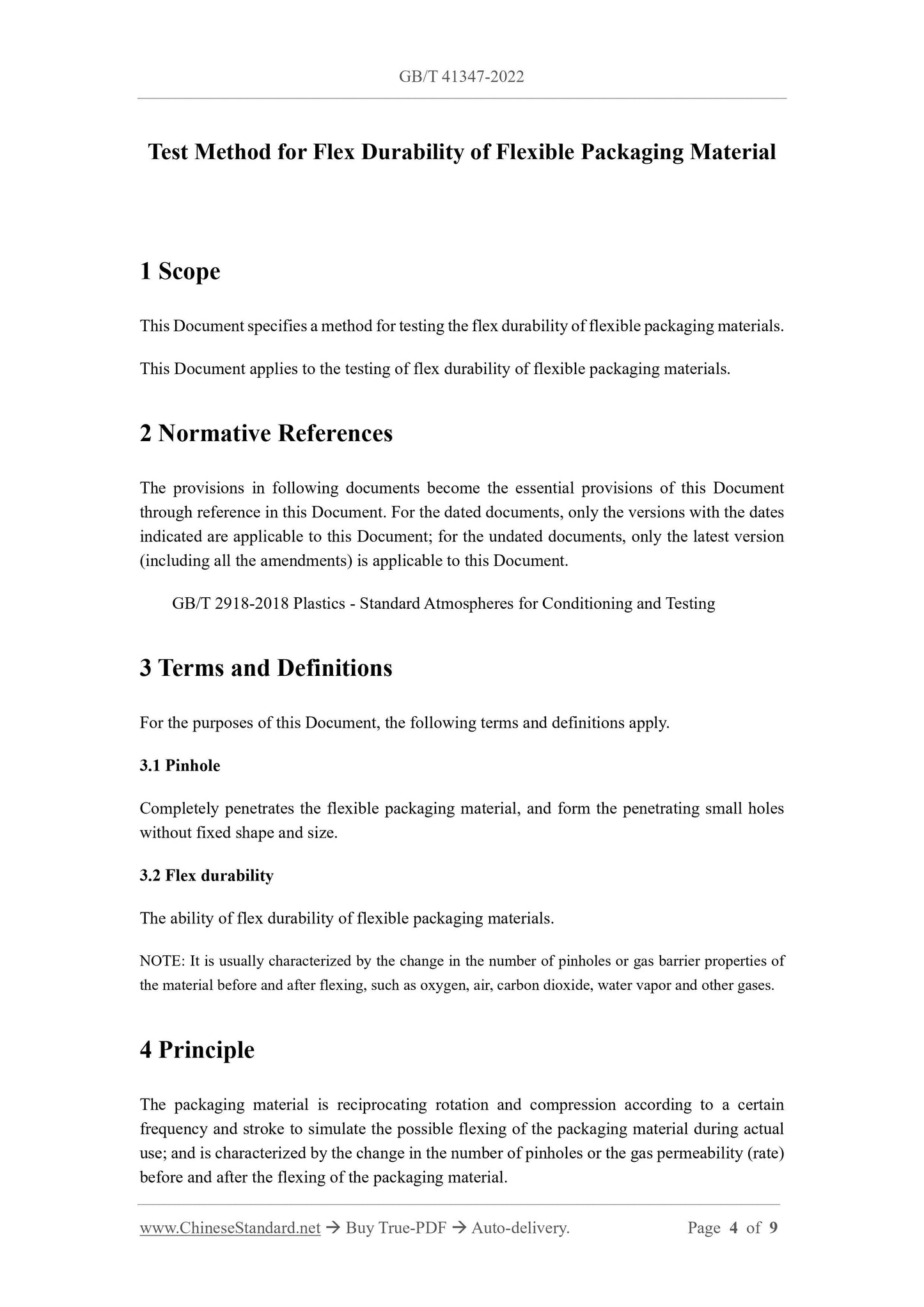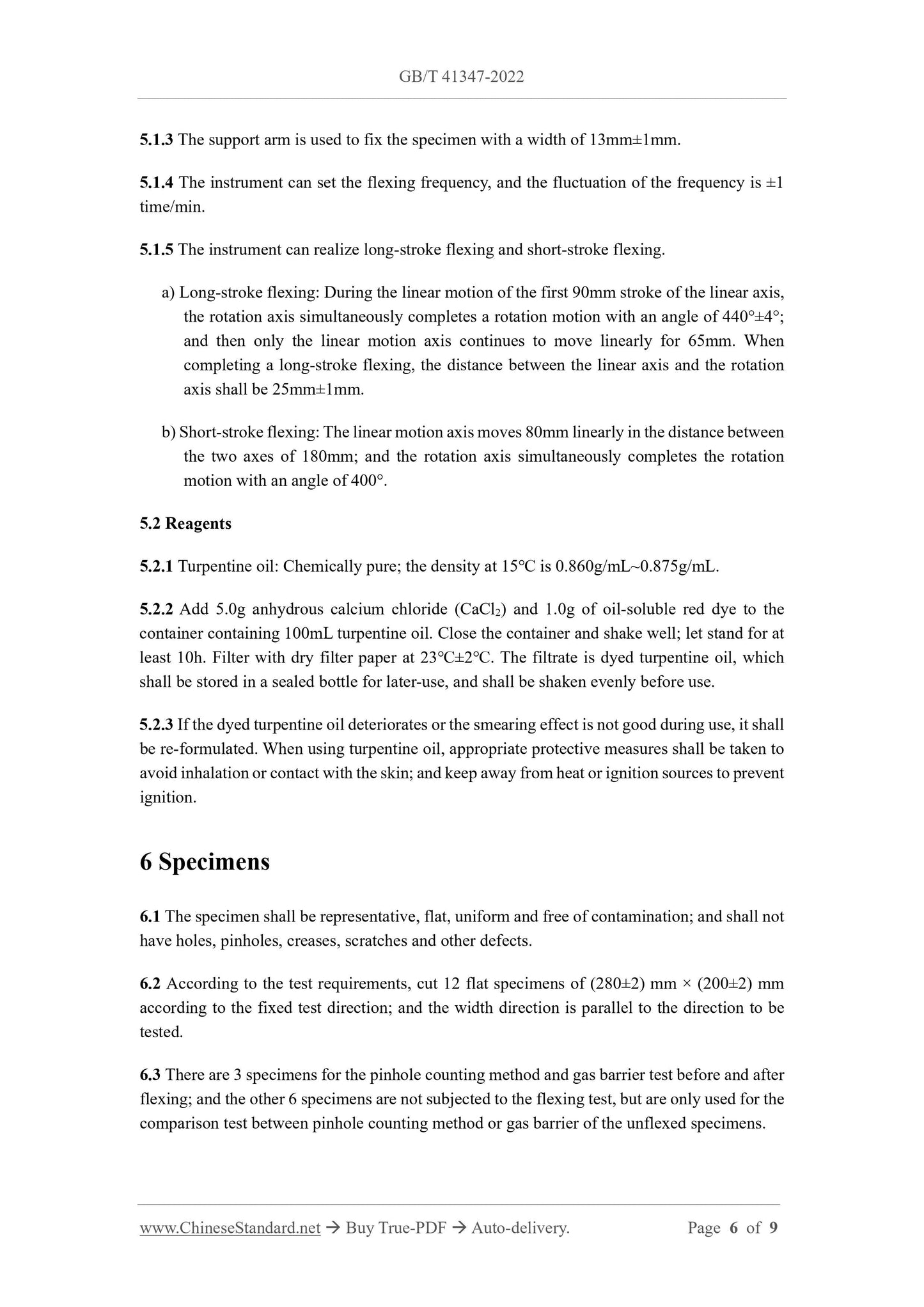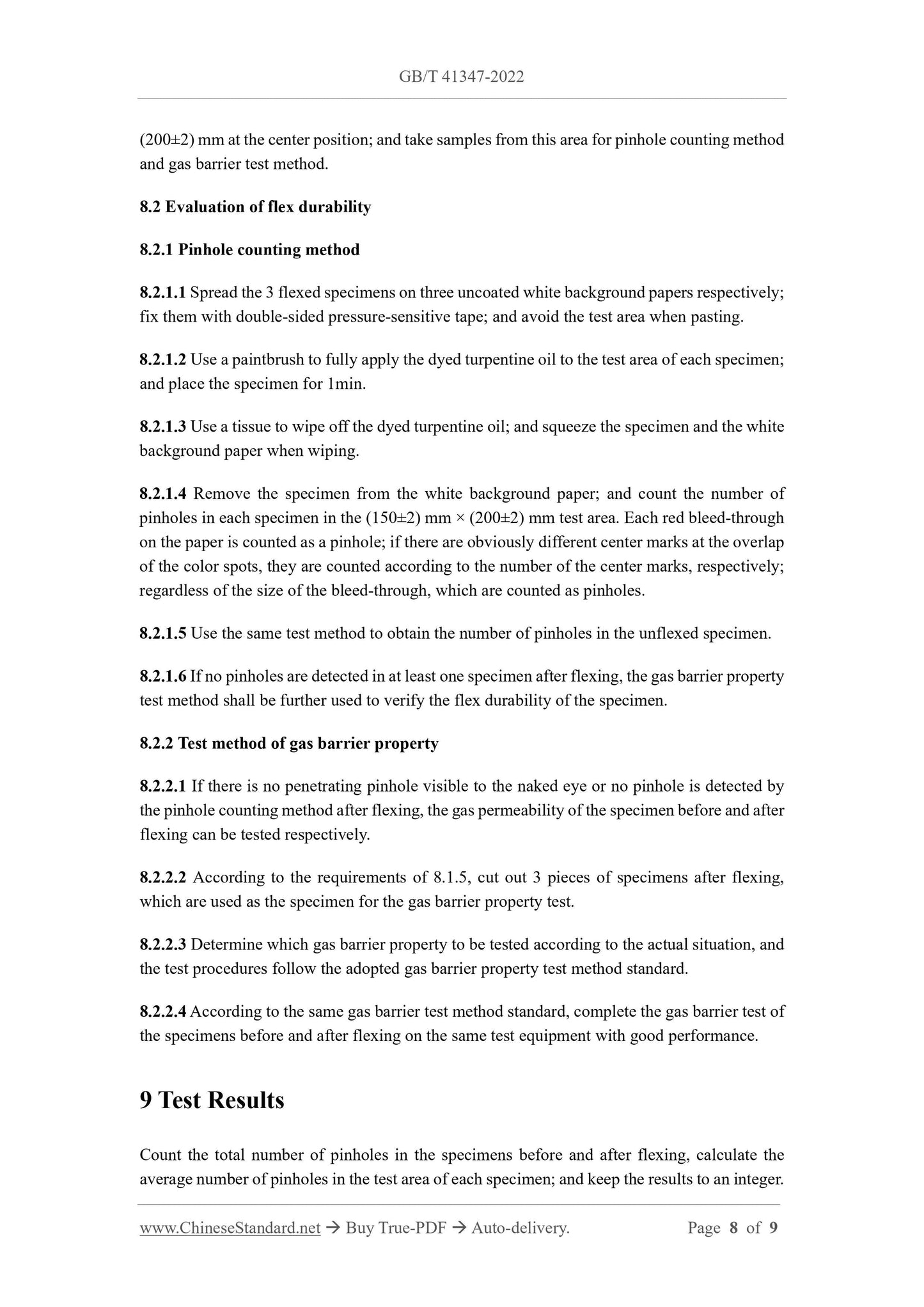1
/
of
5
PayPal, credit cards. Download editable-PDF & invoice in 1 second!
GB/T 41347-2022 English PDF (GBT41347-2022)
GB/T 41347-2022 English PDF (GBT41347-2022)
Regular price
$170.00 USD
Regular price
Sale price
$170.00 USD
Unit price
/
per
Shipping calculated at checkout.
Couldn't load pickup availability
Delivery: 3 seconds. Download true-PDF + Invoice.
Get QUOTATION in 1-minute: Click GB/T 41347-2022
Historical versions: GB/T 41347-2022
Preview True-PDF (Reload/Scroll if blank)
GB/T 41347-2022: Test method for flex durability of flexible packaging material
GB/T 41347-2022
NATIONAL STANDARD OF THE
PEOPLE’S REPUBLIC OF CHINA
ICS 55.020
CCS A 83
Test Method for Flex Durability of Flexible Packaging Material
ISSUED ON. MARCH 09, 2022
IMPLEMENTED ON. OCTOBER 01, 2022
Issued by. State Administration for Market Regulation;
Standardization Administration of the People’s Republic of China.
Table of Contents
Foreword... 3
1 Scope... 4
2 Normative References... 4
3 Terms and Definitions... 4
4 Principle... 4
5 Instruments and Reagents... 5
6 Specimens... 6
7 Sample State Adjustment and Test Conditions... 7
8 Test Procedures... 7
9 Test Results... 8
10 Test Report... 9
Test Method for Flex Durability of Flexible Packaging Material
1 Scope
This Document specifies a method for testing the flex durability of flexible packaging materials.
This Document applies to the testing of flex durability of flexible packaging materials.
2 Normative References
The provisions in following documents become the essential provisions of this Document
through reference in this Document. For the dated documents, only the versions with the dates
indicated are applicable to this Document; for the undated documents, only the latest version
(including all the amendments) is applicable to this Document.
GB/T 2918-2018 Plastics - Standard Atmospheres for Conditioning and Testing
3 Terms and Definitions
For the purposes of this Document, the following terms and definitions apply.
3.1 Pinhole
Completely penetrates the flexible packaging material, and form the penetrating small holes
without fixed shape and size.
3.2 Flex durability
The ability of flex durability of flexible packaging materials.
NOTE. It is usually characterized by the change in the number of pinholes or gas barrier properties of
the material before and after flexing, such as oxygen, air, carbon dioxide, water vapor and other gases.
4 Principle
The packaging material is reciprocating rotation and compression according to a certain
frequency and stroke to simulate the possible flexing of the packaging material during actual
use; and is characterized by the change in the number of pinholes or the gas permeability (rate)
before and after the flexing of the packaging material.
5.1.3 The support arm is used to fix the specimen with a width of 13mm±1mm.
5.1.4 The instrument can set the flexing frequency, and the fluctuation of the frequency is ±1
time/min.
5.1.5 The instrument can realize long-stroke flexing and short-stroke flexing.
a) Long-stroke flexing. During the linear motion of the first 90mm stroke of the linear axis,
the rotation axis simultaneously completes a rotation motion with an angle of 440°±4°;
and then only the linear motion axis continues to move linearly for 65mm. When
completing a long-stroke flexing, the distance between the linear axis and the rotation
axis shall be 25mm±1mm.
b) Short-stroke flexing. The linear motion axis moves 80mm linearly in the distance between
the two axes of 180mm; and the rotation axis simultaneously completes the rotation
motion with an angle of 400°.
5.2 Reagents
5.2.1 Turpentine oil. Chemically pure; the density at 15℃ is 0.860g/mL~0.875g/mL.
5.2.2 Add 5.0g anhydrous calcium chloride (CaCl2) and 1.0g of oil-soluble red dye to the
container containing 100mL turpentine oil. Close the container and shake well; let stand for at
least 10h. Filter with dry filter paper at 23℃±2℃. The filtrate is dyed turpentine oil, which
shall be stored in a sealed bottle for later-use, and shall be shaken evenly before use.
5.2.3 If the dyed turpentine oil deteriorates or the smearing effect is not good during use, it shall
be re-formulated. When using turpentine oil, appropriate protective measures shall be taken to
avoid inhalation or contact with the skin; and keep away from heat or ignition sources to prevent
ignition.
6 Specimens
6.1 The specimen shall be representative, flat, uniform and free of contamination; and shall not
have holes, pinholes, creases, scratches and other defects.
6.2 According to the test requirements, cut 12 flat specimens of (280±2) mm × (200±2) mm
according to the fixed test direction; and the width direction is parallel to the direction to be
tested.
6.3 There are 3 specimens for the pinhole counting method and gas barrier test before and after
flexing; and the other 6 specimens are not subjected to the flexing test, but are only used for the
comparison test between pinhole counting method or gas barrier of the unflexed specimens.
(200±2) mm at the center position; and take samples from this area for pinhole counting method
and gas barrier test method.
8.2 Evaluation of flex durability
8.2.1 Pinhole counting method
8.2.1.1 Spread the 3 flexed specimens on three uncoated white background papers respectively;
fix them with double-sided pressure-sensitive tape; and avoid the test area when pasting.
8.2.1.2 Use a paintbrush to fully apply the dyed turpentine oil to the test area of each specimen;
and place the specimen for 1min.
8.2.1.3 Use a tissue to wipe off the dyed turpentine oil; and squeeze the specimen and the white
background paper when wiping.
8.2.1.4 Remove the specimen from the white background paper; and count the number of
pinholes in each specimen in the (150±2) mm × (200±2) mm test area. Each red bleed-through
on the paper is counted as a pinhole; if there are obviously different center marks at the overlap
of the color spots, they are counted according to the number of the center marks, respectively;
regardless of the size of the bleed-through, which are counted as pinholes.
8.2.1.5 Use the same test method to obtain the number of pinholes in the unflexed specimen.
8.2.1.6 If no pinholes are detected in at least one specimen after flexing, the gas barrier property
test method shall be further used to verify the flex durability of the specimen.
8.2.2 Test method of gas barrier property
8.2.2.1 If there is no penetrating pinhole visible to the naked eye or no pinhole is detected by
the pinhole counting method after flexing, the gas permeability of the specimen before and after
flexing can be tested respectively.
8.2.2.2 According to the requirements of 8.1.5, cut out 3 pieces of specimens after flexing,
which are used as the specimen for the gas barrier property test.
8.2.2.3 Determine which gas barrier property to be tested according to the actual situation, and
the test procedures follow the adopted gas barrier property test method standard.
8.2.2.4 According to the same gas barrier test method standard, complete the gas barrier test of
the specimens before and after flexing on the same test equipment with good performance.
9 Test Results
Count the total number of pinholes in the specimens before and after flexing, calculate the
average number of pinholes in the test area of each specimen; and keep the results to an integer.
Get QUOTATION in 1-minute: Click GB/T 41347-2022
Historical versions: GB/T 41347-2022
Preview True-PDF (Reload/Scroll if blank)
GB/T 41347-2022: Test method for flex durability of flexible packaging material
GB/T 41347-2022
NATIONAL STANDARD OF THE
PEOPLE’S REPUBLIC OF CHINA
ICS 55.020
CCS A 83
Test Method for Flex Durability of Flexible Packaging Material
ISSUED ON. MARCH 09, 2022
IMPLEMENTED ON. OCTOBER 01, 2022
Issued by. State Administration for Market Regulation;
Standardization Administration of the People’s Republic of China.
Table of Contents
Foreword... 3
1 Scope... 4
2 Normative References... 4
3 Terms and Definitions... 4
4 Principle... 4
5 Instruments and Reagents... 5
6 Specimens... 6
7 Sample State Adjustment and Test Conditions... 7
8 Test Procedures... 7
9 Test Results... 8
10 Test Report... 9
Test Method for Flex Durability of Flexible Packaging Material
1 Scope
This Document specifies a method for testing the flex durability of flexible packaging materials.
This Document applies to the testing of flex durability of flexible packaging materials.
2 Normative References
The provisions in following documents become the essential provisions of this Document
through reference in this Document. For the dated documents, only the versions with the dates
indicated are applicable to this Document; for the undated documents, only the latest version
(including all the amendments) is applicable to this Document.
GB/T 2918-2018 Plastics - Standard Atmospheres for Conditioning and Testing
3 Terms and Definitions
For the purposes of this Document, the following terms and definitions apply.
3.1 Pinhole
Completely penetrates the flexible packaging material, and form the penetrating small holes
without fixed shape and size.
3.2 Flex durability
The ability of flex durability of flexible packaging materials.
NOTE. It is usually characterized by the change in the number of pinholes or gas barrier properties of
the material before and after flexing, such as oxygen, air, carbon dioxide, water vapor and other gases.
4 Principle
The packaging material is reciprocating rotation and compression according to a certain
frequency and stroke to simulate the possible flexing of the packaging material during actual
use; and is characterized by the change in the number of pinholes or the gas permeability (rate)
before and after the flexing of the packaging material.
5.1.3 The support arm is used to fix the specimen with a width of 13mm±1mm.
5.1.4 The instrument can set the flexing frequency, and the fluctuation of the frequency is ±1
time/min.
5.1.5 The instrument can realize long-stroke flexing and short-stroke flexing.
a) Long-stroke flexing. During the linear motion of the first 90mm stroke of the linear axis,
the rotation axis simultaneously completes a rotation motion with an angle of 440°±4°;
and then only the linear motion axis continues to move linearly for 65mm. When
completing a long-stroke flexing, the distance between the linear axis and the rotation
axis shall be 25mm±1mm.
b) Short-stroke flexing. The linear motion axis moves 80mm linearly in the distance between
the two axes of 180mm; and the rotation axis simultaneously completes the rotation
motion with an angle of 400°.
5.2 Reagents
5.2.1 Turpentine oil. Chemically pure; the density at 15℃ is 0.860g/mL~0.875g/mL.
5.2.2 Add 5.0g anhydrous calcium chloride (CaCl2) and 1.0g of oil-soluble red dye to the
container containing 100mL turpentine oil. Close the container and shake well; let stand for at
least 10h. Filter with dry filter paper at 23℃±2℃. The filtrate is dyed turpentine oil, which
shall be stored in a sealed bottle for later-use, and shall be shaken evenly before use.
5.2.3 If the dyed turpentine oil deteriorates or the smearing effect is not good during use, it shall
be re-formulated. When using turpentine oil, appropriate protective measures shall be taken to
avoid inhalation or contact with the skin; and keep away from heat or ignition sources to prevent
ignition.
6 Specimens
6.1 The specimen shall be representative, flat, uniform and free of contamination; and shall not
have holes, pinholes, creases, scratches and other defects.
6.2 According to the test requirements, cut 12 flat specimens of (280±2) mm × (200±2) mm
according to the fixed test direction; and the width direction is parallel to the direction to be
tested.
6.3 There are 3 specimens for the pinhole counting method and gas barrier test before and after
flexing; and the other 6 specimens are not subjected to the flexing test, but are only used for the
comparison test between pinhole counting method or gas barrier of the unflexed specimens.
(200±2) mm at the center position; and take samples from this area for pinhole counting method
and gas barrier test method.
8.2 Evaluation of flex durability
8.2.1 Pinhole counting method
8.2.1.1 Spread the 3 flexed specimens on three uncoated white background papers respectively;
fix them with double-sided pressure-sensitive tape; and avoid the test area when pasting.
8.2.1.2 Use a paintbrush to fully apply the dyed turpentine oil to the test area of each specimen;
and place the specimen for 1min.
8.2.1.3 Use a tissue to wipe off the dyed turpentine oil; and squeeze the specimen and the white
background paper when wiping.
8.2.1.4 Remove the specimen from the white background paper; and count the number of
pinholes in each specimen in the (150±2) mm × (200±2) mm test area. Each red bleed-through
on the paper is counted as a pinhole; if there are obviously different center marks at the overlap
of the color spots, they are counted according to the number of the center marks, respectively;
regardless of the size of the bleed-through, which are counted as pinholes.
8.2.1.5 Use the same test method to obtain the number of pinholes in the unflexed specimen.
8.2.1.6 If no pinholes are detected in at least one specimen after flexing, the gas barrier property
test method shall be further used to verify the flex durability of the specimen.
8.2.2 Test method of gas barrier property
8.2.2.1 If there is no penetrating pinhole visible to the naked eye or no pinhole is detected by
the pinhole counting method after flexing, the gas permeability of the specimen before and after
flexing can be tested respectively.
8.2.2.2 According to the requirements of 8.1.5, cut out 3 pieces of specimens after flexing,
which are used as the specimen for the gas barrier property test.
8.2.2.3 Determine which gas barrier property to be tested according to the actual situation, and
the test procedures follow the adopted gas barrier property test method standard.
8.2.2.4 According to the same gas barrier test method standard, complete the gas barrier test of
the specimens before and after flexing on the same test equipment with good performance.
9 Test Results
Count the total number of pinholes in the specimens before and after flexing, calculate the
average number of pinholes in the test area of each specimen; and keep the results to an integer.
Share
